MT455 Unit 6: Oligopoly and Monopolistic Competition Analysis
VerifiedAdded on 2022/08/21
|7
|977
|20
Homework Assignment
AI Summary
This economics assignment analyzes oligopoly and monopolistically competitive market structures, focusing on profit maximization and strategic decision-making. The assignment begins by exploring the interdependent nature of firms in an oligopoly, discussing how few firms influence market prices and output. It then delves into a scenario involving a perfectly competitive firm, calculating total cost, total revenue, and profit/loss at various output levels to determine optimal production quantities. The analysis extends to monopolistically competitive firms, where the assignment examines how firms minimize losses or maximize profits by equating marginal revenue and marginal cost. The assignment also includes a pay-off matrix to evaluate marketing strategies within an oligopoly market, identifying dominant strategies and Nash equilibrium points. The student provides detailed answers and calculations, demonstrating an understanding of market dynamics and economic principles.
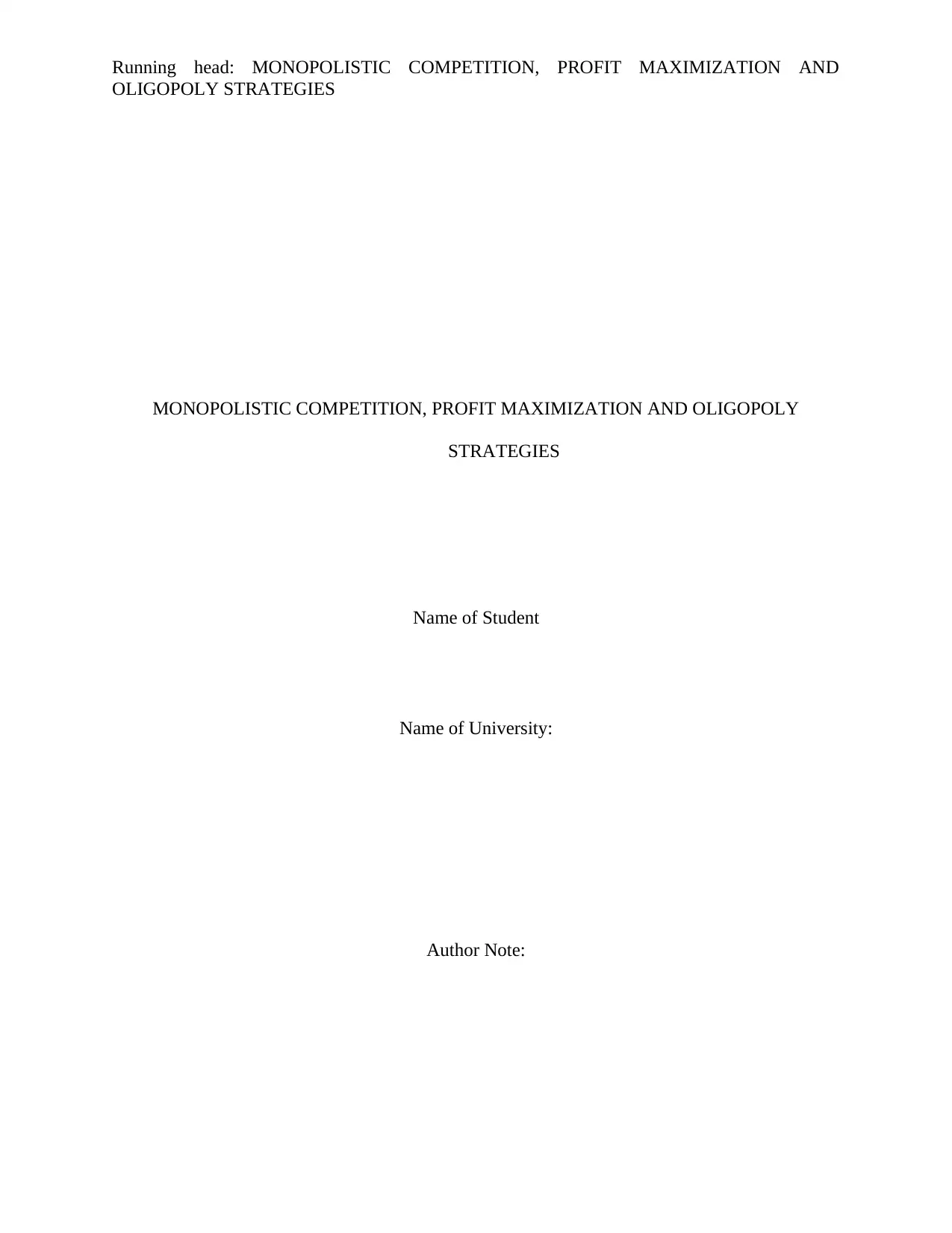
Running head: MONOPOLISTIC COMPETITION, PROFIT MAXIMIZATION AND
OLIGOPOLY STRATEGIES
MONOPOLISTIC COMPETITION, PROFIT MAXIMIZATION AND OLIGOPOLY
STRATEGIES
Name of Student
Name of University:
Author Note:
OLIGOPOLY STRATEGIES
MONOPOLISTIC COMPETITION, PROFIT MAXIMIZATION AND OLIGOPOLY
STRATEGIES
Name of Student
Name of University:
Author Note:
Paraphrase This Document
Need a fresh take? Get an instant paraphrase of this document with our AI Paraphraser

1
MONOPOLISTIC COMPETITION, PROFIT MAXIMIZATION AND OLIGOPOLY
STRATEGIES
Table of Contents
Answer to Question: 1.....................................................................................................................2
Answer to Question: 2.....................................................................................................................3
Answer a..........................................................................................................................................3
Answer b......................................................................................................................................3
Answer c......................................................................................................................................3
Answer to Question: 3.....................................................................................................................4
Answer a......................................................................................................................................4
Answer b......................................................................................................................................4
Answer c......................................................................................................................................4
Answer to Question: 4.....................................................................................................................5
Answer a......................................................................................................................................5
Answer b......................................................................................................................................5
Answer c......................................................................................................................................5
Reference List..................................................................................................................................7
MONOPOLISTIC COMPETITION, PROFIT MAXIMIZATION AND OLIGOPOLY
STRATEGIES
Table of Contents
Answer to Question: 1.....................................................................................................................2
Answer to Question: 2.....................................................................................................................3
Answer a..........................................................................................................................................3
Answer b......................................................................................................................................3
Answer c......................................................................................................................................3
Answer to Question: 3.....................................................................................................................4
Answer a......................................................................................................................................4
Answer b......................................................................................................................................4
Answer c......................................................................................................................................4
Answer to Question: 4.....................................................................................................................5
Answer a......................................................................................................................................5
Answer b......................................................................................................................................5
Answer c......................................................................................................................................5
Reference List..................................................................................................................................7
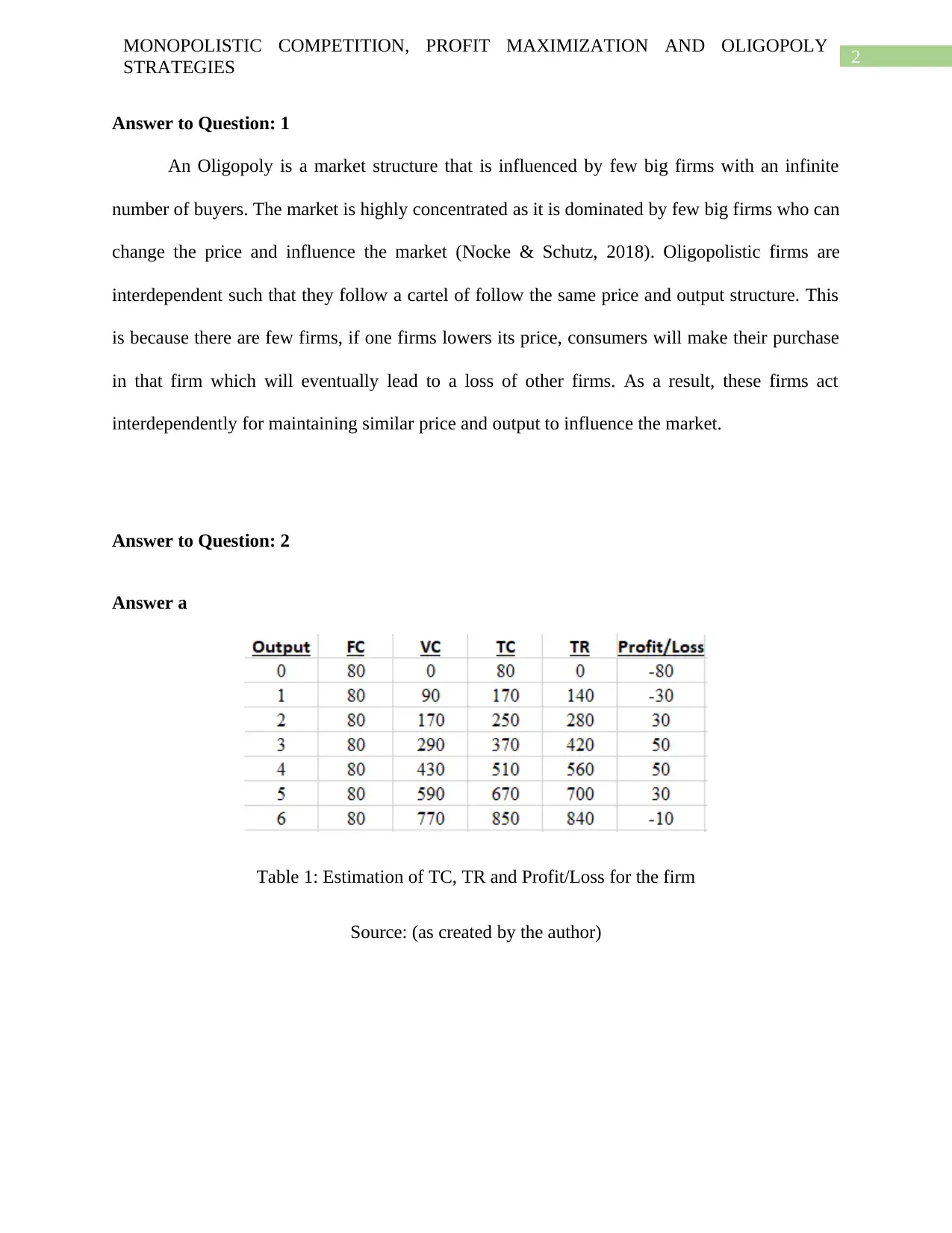
2
MONOPOLISTIC COMPETITION, PROFIT MAXIMIZATION AND OLIGOPOLY
STRATEGIES
Answer to Question: 1
An Oligopoly is a market structure that is influenced by few big firms with an infinite
number of buyers. The market is highly concentrated as it is dominated by few big firms who can
change the price and influence the market (Nocke & Schutz, 2018). Oligopolistic firms are
interdependent such that they follow a cartel of follow the same price and output structure. This
is because there are few firms, if one firms lowers its price, consumers will make their purchase
in that firm which will eventually lead to a loss of other firms. As a result, these firms act
interdependently for maintaining similar price and output to influence the market.
Answer to Question: 2
Answer a
Table 1: Estimation of TC, TR and Profit/Loss for the firm
Source: (as created by the author)
MONOPOLISTIC COMPETITION, PROFIT MAXIMIZATION AND OLIGOPOLY
STRATEGIES
Answer to Question: 1
An Oligopoly is a market structure that is influenced by few big firms with an infinite
number of buyers. The market is highly concentrated as it is dominated by few big firms who can
change the price and influence the market (Nocke & Schutz, 2018). Oligopolistic firms are
interdependent such that they follow a cartel of follow the same price and output structure. This
is because there are few firms, if one firms lowers its price, consumers will make their purchase
in that firm which will eventually lead to a loss of other firms. As a result, these firms act
interdependently for maintaining similar price and output to influence the market.
Answer to Question: 2
Answer a
Table 1: Estimation of TC, TR and Profit/Loss for the firm
Source: (as created by the author)
⊘ This is a preview!⊘
Do you want full access?
Subscribe today to unlock all pages.

Trusted by 1+ million students worldwide
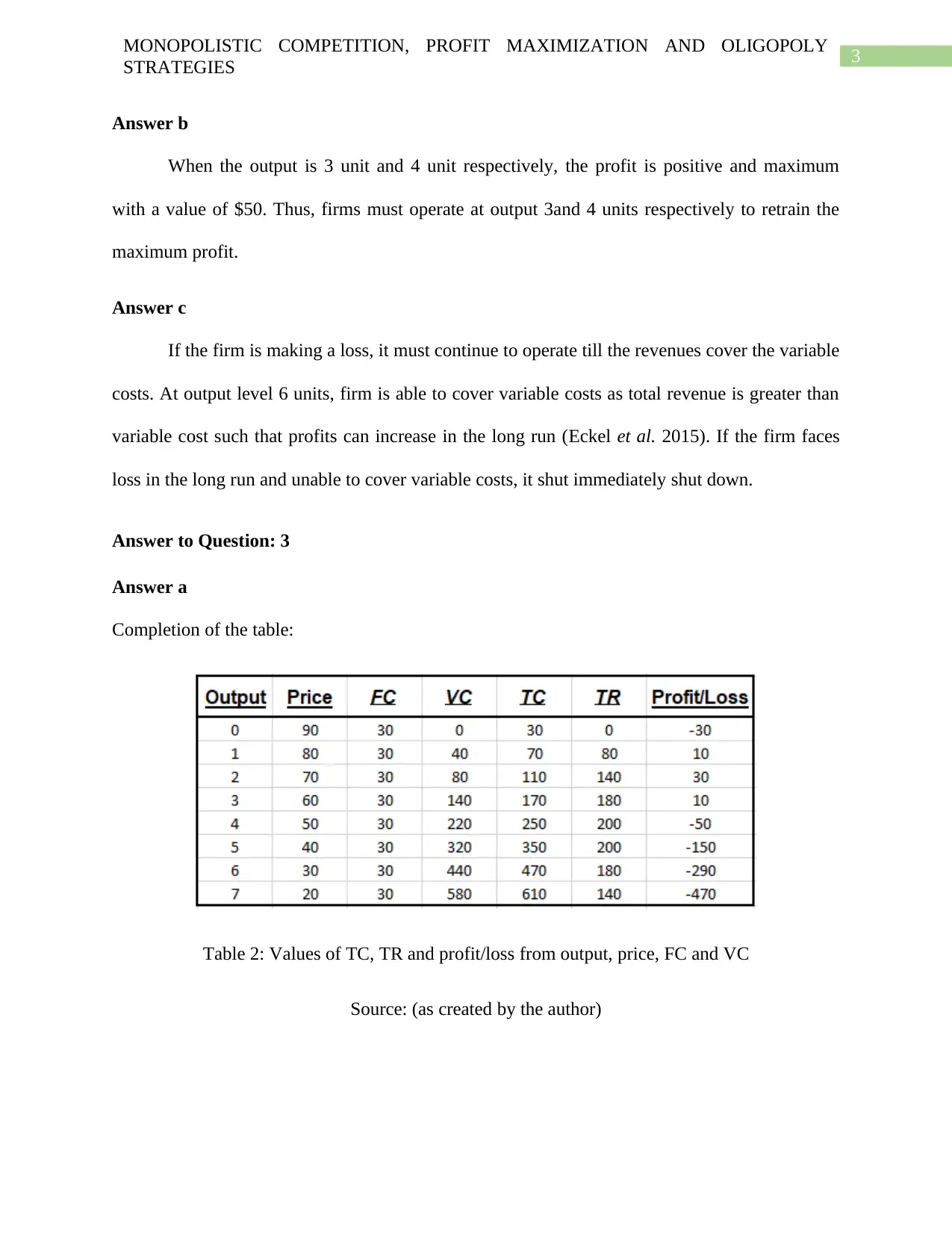
3
MONOPOLISTIC COMPETITION, PROFIT MAXIMIZATION AND OLIGOPOLY
STRATEGIES
Answer b
When the output is 3 unit and 4 unit respectively, the profit is positive and maximum
with a value of $50. Thus, firms must operate at output 3and 4 units respectively to retrain the
maximum profit.
Answer c
If the firm is making a loss, it must continue to operate till the revenues cover the variable
costs. At output level 6 units, firm is able to cover variable costs as total revenue is greater than
variable cost such that profits can increase in the long run (Eckel et al. 2015). If the firm faces
loss in the long run and unable to cover variable costs, it shut immediately shut down.
Answer to Question: 3
Answer a
Completion of the table:
Table 2: Values of TC, TR and profit/loss from output, price, FC and VC
Source: (as created by the author)
MONOPOLISTIC COMPETITION, PROFIT MAXIMIZATION AND OLIGOPOLY
STRATEGIES
Answer b
When the output is 3 unit and 4 unit respectively, the profit is positive and maximum
with a value of $50. Thus, firms must operate at output 3and 4 units respectively to retrain the
maximum profit.
Answer c
If the firm is making a loss, it must continue to operate till the revenues cover the variable
costs. At output level 6 units, firm is able to cover variable costs as total revenue is greater than
variable cost such that profits can increase in the long run (Eckel et al. 2015). If the firm faces
loss in the long run and unable to cover variable costs, it shut immediately shut down.
Answer to Question: 3
Answer a
Completion of the table:
Table 2: Values of TC, TR and profit/loss from output, price, FC and VC
Source: (as created by the author)
Paraphrase This Document
Need a fresh take? Get an instant paraphrase of this document with our AI Paraphraser
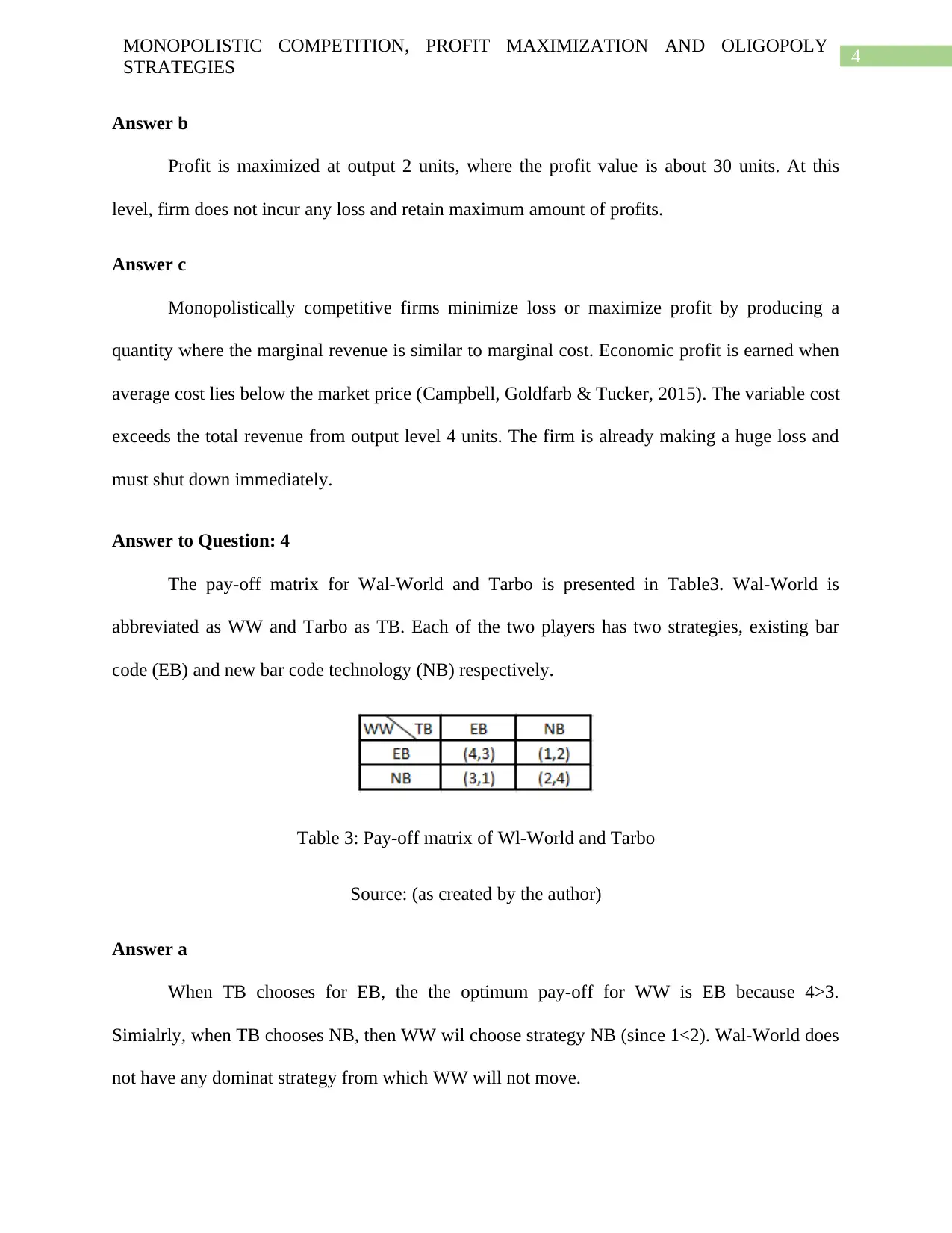
4
MONOPOLISTIC COMPETITION, PROFIT MAXIMIZATION AND OLIGOPOLY
STRATEGIES
Answer b
Profit is maximized at output 2 units, where the profit value is about 30 units. At this
level, firm does not incur any loss and retain maximum amount of profits.
Answer c
Monopolistically competitive firms minimize loss or maximize profit by producing a
quantity where the marginal revenue is similar to marginal cost. Economic profit is earned when
average cost lies below the market price (Campbell, Goldfarb & Tucker, 2015). The variable cost
exceeds the total revenue from output level 4 units. The firm is already making a huge loss and
must shut down immediately.
Answer to Question: 4
The pay-off matrix for Wal-World and Tarbo is presented in Table3. Wal-World is
abbreviated as WW and Tarbo as TB. Each of the two players has two strategies, existing bar
code (EB) and new bar code technology (NB) respectively.
Table 3: Pay-off matrix of Wl-World and Tarbo
Source: (as created by the author)
Answer a
When TB chooses for EB, the the optimum pay-off for WW is EB because 4>3.
Simialrly, when TB chooses NB, then WW wil choose strategy NB (since 1<2). Wal-World does
not have any dominat strategy from which WW will not move.
MONOPOLISTIC COMPETITION, PROFIT MAXIMIZATION AND OLIGOPOLY
STRATEGIES
Answer b
Profit is maximized at output 2 units, where the profit value is about 30 units. At this
level, firm does not incur any loss and retain maximum amount of profits.
Answer c
Monopolistically competitive firms minimize loss or maximize profit by producing a
quantity where the marginal revenue is similar to marginal cost. Economic profit is earned when
average cost lies below the market price (Campbell, Goldfarb & Tucker, 2015). The variable cost
exceeds the total revenue from output level 4 units. The firm is already making a huge loss and
must shut down immediately.
Answer to Question: 4
The pay-off matrix for Wal-World and Tarbo is presented in Table3. Wal-World is
abbreviated as WW and Tarbo as TB. Each of the two players has two strategies, existing bar
code (EB) and new bar code technology (NB) respectively.
Table 3: Pay-off matrix of Wl-World and Tarbo
Source: (as created by the author)
Answer a
When TB chooses for EB, the the optimum pay-off for WW is EB because 4>3.
Simialrly, when TB chooses NB, then WW wil choose strategy NB (since 1<2). Wal-World does
not have any dominat strategy from which WW will not move.
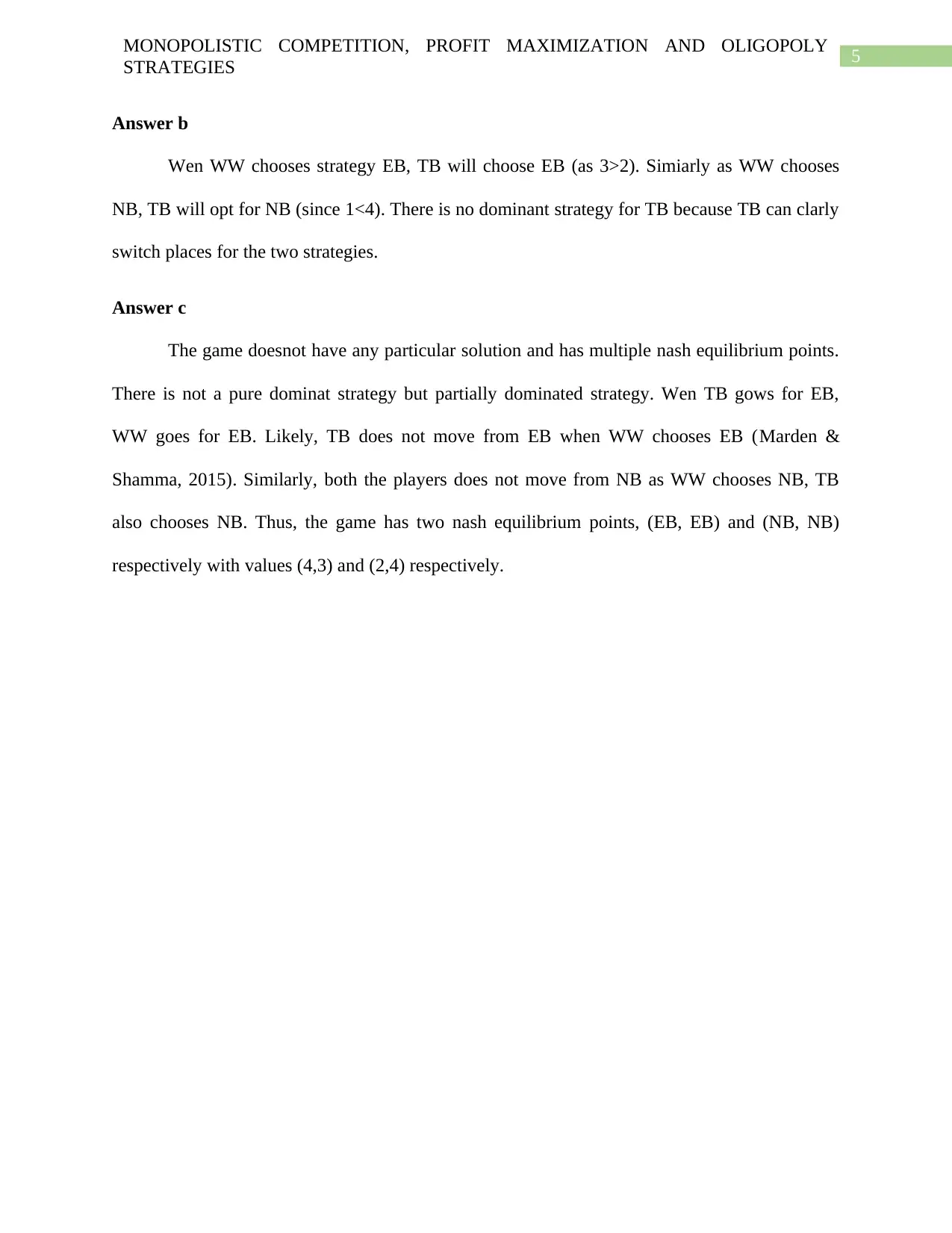
5
MONOPOLISTIC COMPETITION, PROFIT MAXIMIZATION AND OLIGOPOLY
STRATEGIES
Answer b
Wen WW chooses strategy EB, TB will choose EB (as 3>2). Simiarly as WW chooses
NB, TB will opt for NB (since 1<4). There is no dominant strategy for TB because TB can clarly
switch places for the two strategies.
Answer c
The game doesnot have any particular solution and has multiple nash equilibrium points.
There is not a pure dominat strategy but partially dominated strategy. Wen TB gows for EB,
WW goes for EB. Likely, TB does not move from EB when WW chooses EB (Marden &
Shamma, 2015). Similarly, both the players does not move from NB as WW chooses NB, TB
also chooses NB. Thus, the game has two nash equilibrium points, (EB, EB) and (NB, NB)
respectively with values (4,3) and (2,4) respectively.
MONOPOLISTIC COMPETITION, PROFIT MAXIMIZATION AND OLIGOPOLY
STRATEGIES
Answer b
Wen WW chooses strategy EB, TB will choose EB (as 3>2). Simiarly as WW chooses
NB, TB will opt for NB (since 1<4). There is no dominant strategy for TB because TB can clarly
switch places for the two strategies.
Answer c
The game doesnot have any particular solution and has multiple nash equilibrium points.
There is not a pure dominat strategy but partially dominated strategy. Wen TB gows for EB,
WW goes for EB. Likely, TB does not move from EB when WW chooses EB (Marden &
Shamma, 2015). Similarly, both the players does not move from NB as WW chooses NB, TB
also chooses NB. Thus, the game has two nash equilibrium points, (EB, EB) and (NB, NB)
respectively with values (4,3) and (2,4) respectively.
⊘ This is a preview!⊘
Do you want full access?
Subscribe today to unlock all pages.

Trusted by 1+ million students worldwide
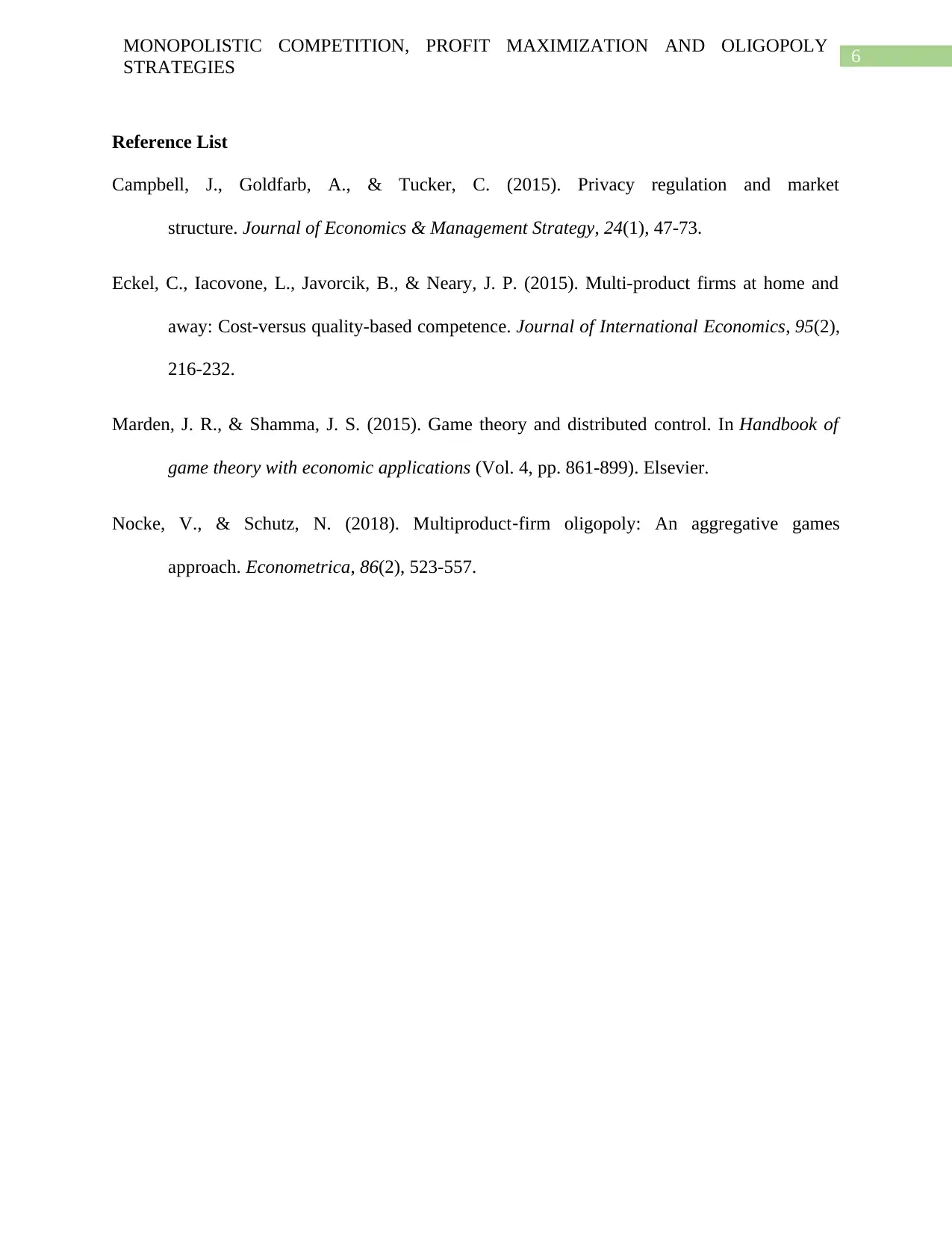
6
MONOPOLISTIC COMPETITION, PROFIT MAXIMIZATION AND OLIGOPOLY
STRATEGIES
Reference List
Campbell, J., Goldfarb, A., & Tucker, C. (2015). Privacy regulation and market
structure. Journal of Economics & Management Strategy, 24(1), 47-73.
Eckel, C., Iacovone, L., Javorcik, B., & Neary, J. P. (2015). Multi-product firms at home and
away: Cost-versus quality-based competence. Journal of International Economics, 95(2),
216-232.
Marden, J. R., & Shamma, J. S. (2015). Game theory and distributed control. In Handbook of
game theory with economic applications (Vol. 4, pp. 861-899). Elsevier.
Nocke, V., & Schutz, N. (2018). Multiproduct‐firm oligopoly: An aggregative games
approach. Econometrica, 86(2), 523-557.
MONOPOLISTIC COMPETITION, PROFIT MAXIMIZATION AND OLIGOPOLY
STRATEGIES
Reference List
Campbell, J., Goldfarb, A., & Tucker, C. (2015). Privacy regulation and market
structure. Journal of Economics & Management Strategy, 24(1), 47-73.
Eckel, C., Iacovone, L., Javorcik, B., & Neary, J. P. (2015). Multi-product firms at home and
away: Cost-versus quality-based competence. Journal of International Economics, 95(2),
216-232.
Marden, J. R., & Shamma, J. S. (2015). Game theory and distributed control. In Handbook of
game theory with economic applications (Vol. 4, pp. 861-899). Elsevier.
Nocke, V., & Schutz, N. (2018). Multiproduct‐firm oligopoly: An aggregative games
approach. Econometrica, 86(2), 523-557.
1 out of 7
Related Documents
Your All-in-One AI-Powered Toolkit for Academic Success.
+13062052269
info@desklib.com
Available 24*7 on WhatsApp / Email
![[object Object]](/_next/static/media/star-bottom.7253800d.svg)
Unlock your academic potential
Copyright © 2020–2025 A2Z Services. All Rights Reserved. Developed and managed by ZUCOL.





